Klaus R. Jelitto: My Recollections of 50 Years in the Seed Trade
© Klaus R. Jelitto, Hamburg
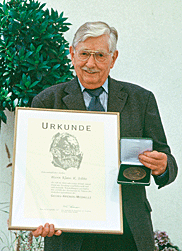 Why the seed trade?
Why the seed trade?
I was brought up in the knowledge that my future would be in the seed trade (albeit forest seeds) That is to say, my mother's family ran the company J.M. Helms Söhne, (forest tree seed and conifer seed treatment) founded 1788 in Tabarz/Thüringen, Germany and I was the sole male descendant.
J.M. Helm's Söhne
Hoflieferant Sr. Majestät des deutschen Kaisers u. Königs
von Preussen
Herzogliche Hofsamenhandlung
und Klenganstalt
Grosstabarz i. Thür.
-:- Gegründet 1788 -:-
When I left school in 1949, it was not yet clear whether Thüringen, East Germany would be in East or West Germany. This finally foiled my ambitions in the family business and caused my solo debut in the seed trade. It was an interesting and exciting journey from 1949 until setting up my own business in 1957(registered 1st October). The trail started in Stuttgart, then led to Lintorf/Germany, Schifferstadt/Germany, Copenhagen/Denmark, Landskrona/Sweden, Johannesburg/South Africa and Braunschweig/Germany. Finally, in 1957, I was back in Stuttgart to complete the necessary paperwork to set up my own company.
Starting from scratch
During my life, I have always been blessed with good luck. Nevertheless, the path which led to me starting my own business was long, winding and often stony.
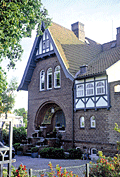 The first company to be registered in my name in Stuttgart was in 1957 the "Klaus Jelitto Gartenbauagentur" for Scandinavia based in Landskrona, Sweden.
The first company to be registered in my name in Stuttgart was in 1957 the "Klaus Jelitto Gartenbauagentur" for Scandinavia based in Landskrona, Sweden.
I had already been able to sign the necessary contracts for my requirements with the leading German suppliers, these being: Benary Blumensamen in Hann.Münden; Rudolf Schmidt Baumschule in Rellingen (today Euro-Baumschule Rudolf Schmidt); Hermann Meyer, Gartenzubehör in Rellingen; Hagemann Staudenkulturen in Krähenwinkel; Scherrer, Azaleen, in Bremen; Süptitz Jungpflanzen in Hamburg; Holtkamp Saintpaulien, in Isselburg; Heinrich H. Buhk Maiblumenkeimein Hamburg and Wilhelm Dierking, (American Blueberries - Vaccinium corymbosum) in Nienhagen.
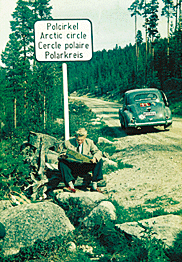 I started out in my VW beetle (bought for all of 900 DM complete with rusting door) from Stuttgart to Landskrona in Sweden and rented a small room there. This functioned as office, bedroom and kitchen. Landskrona was the ideal base for sales trips to Denmark and Sweden. Journeys to Finland and Norway were undertaken only once a year (the longer distance being a slight hindrance). In those days it was often possible to take a room in private houses but more than once I swapped a hotel room for the backseat of my old VW, ideal location, woods, romantic lake view with bathing facilities on hand! Sweden, land of the lakes and woodlands, was good to me. To my surprise, when I started making my first visits, my name had already made the rounds; the reason for this was that in the summer of 1956 while I was working for the Plant Breeding Institute in Weibullsholm (Växtförädlingsanstalt Weibullsholm was partly state financed and was connected to the seed company W. Weibull AB of Landskrona) I had acted as a guide for the visiting groups of German and Swedish plant breeding experts and enthusiasts. We are talking about 20.000 visitors per year, from associations, clubs, schools and of course, seed wholesalers, from Europe and the rest of the world. From the beginning W. Weibull AB was one of my best customers for which I am immensely grateful as I also am for the help I received from my ex-colleagues in introducing me to potential customers all over Scandinavia.
I started out in my VW beetle (bought for all of 900 DM complete with rusting door) from Stuttgart to Landskrona in Sweden and rented a small room there. This functioned as office, bedroom and kitchen. Landskrona was the ideal base for sales trips to Denmark and Sweden. Journeys to Finland and Norway were undertaken only once a year (the longer distance being a slight hindrance). In those days it was often possible to take a room in private houses but more than once I swapped a hotel room for the backseat of my old VW, ideal location, woods, romantic lake view with bathing facilities on hand! Sweden, land of the lakes and woodlands, was good to me. To my surprise, when I started making my first visits, my name had already made the rounds; the reason for this was that in the summer of 1956 while I was working for the Plant Breeding Institute in Weibullsholm (Växtförädlingsanstalt Weibullsholm was partly state financed and was connected to the seed company W. Weibull AB of Landskrona) I had acted as a guide for the visiting groups of German and Swedish plant breeding experts and enthusiasts. We are talking about 20.000 visitors per year, from associations, clubs, schools and of course, seed wholesalers, from Europe and the rest of the world. From the beginning W. Weibull AB was one of my best customers for which I am immensely grateful as I also am for the help I received from my ex-colleagues in introducing me to potential customers all over Scandinavia.
In 1958, in spite of our dire financial situation, my wife Margot and I got married. Margot, who also had professional experience in the seed trade, now held the fort in our versatile abode whilst I travelled the countryside on the lookout for orders for the firms to which we were contracted.
Financially, this initial stage of the business was a hard slog. The deliveries were usually booked for the autumn or spring and since no payment was due until three to six months after delivery and our commission was paid once a quarter, we had a struggle to make ends meet. We lived off potatosoup (the bacon rind was free from the butcher) and self picked spinach (the freezer company Findus had fields nearby!). This situation drove me to revert to a hobby which I had practised as a young lad. Wherever and whenever I could, I collected perennial seeds, from friends, nearby firms and of course with permission, from Weibull's trial fields.
I obtained written permission from Friedrich Benary, then owner of Benary in Hann. Münden, to sell perennial seeds in my own name but only directly to growers. I was under contract to Benary to sell seeds to wholesalers for them, so naturally any seeds which were in the Benary range, had to be bought from them. In time, I received more and more offers of surplus seed from growers in Scandinavia, species which were not usually to be found on seed lists but which other growers were wanting to buy. Without even having to invest in advertising, I was soon receiving inquiries from Austria, Germany and Switzerland. However, years were still to pass before this sideline would become really profitable.
First removal
Towards the end of 1958, the landlady of our bedsit/office (a very nice person, by the way) commented with a knowing glance at my wife, that our rented domicile would probably soon be too small for three. The cheapest accommodation that we then managed to find was opposite the cinema (not exactly quiet). It was an old-fashioned, furnished, 2 room flat with a kitchen but no bathroom. The toilet was on the downstairs landing. Still, at last we had enough space in the living room for the office as well as a cot for our daughter Jeannette.
There is always light at the end of the tunnel!
By the end of the summer of 1959 I was ready to give up. What with the arrival of our baby daughter in May, we were completely penniless. I no longer felt able to take on the risk of being self-employed with no resources. However, shortly before, I had secured a very large order for azaleas for Autumn delivery to be supplied by a company named Scherrer in Bremen. Oskar Scherrer made a surprise visit in order to make the acquaintance of this lucrative new customer (and probably to check on his solvency). The result was clearly positive so that the next day, when Oskar Scherrer was taking leave of my wife and I, he drew his wallet from his jacket and insisted on giving us a "small" advance. This turned out to be 2000 DM - a fortune in those days! He must have noticed something. This was the turning point for our business.Thank you Oskar Scherrer!
That's when things really took off...
In 1960 the relationships with our customers in Sweden and Denmark were on such a sound footing that my wife and I (and our daughter of course) felt free to move from Landskrona in Sweden to Halstenbek, Kreis Pinneberg (in Germany). I was now in a position to respond quickly and competently (the area around Halstenbek is full of nurseries) to the frequent enquiries from customers. This was vital since the competition in Holland and latterly Poland and East Germany was also on the ball. In actual fact, I was responsible for the organisation in Sweden and Finland of the last two weekend fairs of the Exportkontor Gartenbau (this later became part of the CMA).
The perennial seed side of the business now based in Halstenbek in Germany, proceeded to develop in a remarkable fashion. The crops, which we processed ourselves, were becoming larger and larger. The duplicated seed lists were getting longer and longer. The flat in Halstenbek was just not big enough. Our storage capacity had long since outgrown the cardboard box stage. Without hesitation, our landlord, the building contractor Emil Hatje, offered to let us convert the attic of the house to meet our requirements. The first three years would be rent free, provided, of course, we bought our building material from him. Perfect! One of our next door neighbours, a teacher, agreed to work in the office in the afternoons and thus became our first employee.
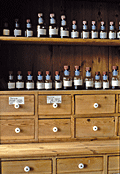 Two years later and our office/storage capacity was again bursting at the seams! By chance we discovered an old house which was on the list of protected buildings in the marketplace of the neighbouring town of Rellingen.. This was the ideal site for our young company and would (initially) provide enough space for our expanding needs. Mr. Hatje converted the old office in the attic into a comfortable appartment which was let in no time at all. We acquired another office worker. In winter, during the peak season when we were dispatching the largest quantities of seeds, Wachter Perennial Nursery in Pinneberg, lent us the necessary additional staff since their nursery was relatively quiet, though for us this was the busiest time of the year.
Two years later and our office/storage capacity was again bursting at the seams! By chance we discovered an old house which was on the list of protected buildings in the marketplace of the neighbouring town of Rellingen.. This was the ideal site for our young company and would (initially) provide enough space for our expanding needs. Mr. Hatje converted the old office in the attic into a comfortable appartment which was let in no time at all. We acquired another office worker. In winter, during the peak season when we were dispatching the largest quantities of seeds, Wachter Perennial Nursery in Pinneberg, lent us the necessary additional staff since their nursery was relatively quiet, though for us this was the busiest time of the year.
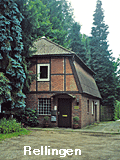 Business from Scandinavia was increasingly lively. Sweden's largest building contractor, BPA, was erecting satellite towns (near Göteborg, örebro, Stockholm etc.) and they became one of our best customers. Another good customer was the Swedish Ministry of Aviation which built three new airports with parking facilities (Malmö-Skurup, Göteborg-Landvetter and Stockholm-Arlanda where I was allowed to test my latest car on the newly laid runway).
Business from Scandinavia was increasingly lively. Sweden's largest building contractor, BPA, was erecting satellite towns (near Göteborg, örebro, Stockholm etc.) and they became one of our best customers. Another good customer was the Swedish Ministry of Aviation which built three new airports with parking facilities (Malmö-Skurup, Göteborg-Landvetter and Stockholm-Arlanda where I was allowed to test my latest car on the newly laid runway).
However, for me, the most remarkable and interesting customer was King Gustav VI. Adolf, who wanted to replace three enormous chestnut trees in the avenue leading up to his summer residence, Castle Drottningholm near Stockholm. He even wanted a photo of the trees before placing the order! Rudolf Schmidt actually managed to find such gigantic solitary chestnuts in Niederrhein/Germany for several thousand Marks and the King agreed after having seen the photographs. The trees were shipped by rail, each on a separate wagon. It turned out that King Gustav VI Adolf had studied geology and was also an excellent botanist. He was a first rate authority on perennials and so for many years we were allowed to collect seeds in "Sofiero" the King's castle garden near Helsingborg. Nowadays it is still an interesting botanical park.
"Pelargonium", a fascinating interlude

Many of my wholesale customers in Sweden had long had problems in obtaining sufficient young plants of Pelargonium (commonly called geraniums). I took up this challenge and in 1962, together with Heinrich Hagemann, started a young plant nursery in Krähenwinkel near the airport in Hanover, Germany. First we needed mother plants in order to produce cuttings. I managed to procure the most popular varieties at that time. A Danish company selling young plants was prepared to produce unrooted cuttings for us on Sardinia. We flew the mother plants out with Lufthansa. They never (apparently) arrived. Lufthansa confirmed that Alitalia in Rome had signed for the safe arrival of the goods but in Cagliari on Sardina, no freight could (officially) be found. Even the Plant Protection Office had seen no plants!
Heinz Hagemann immediately contacted a client of his (Mr.Suavet) in Algeria who was in the process of moving to Corsica. (In 1962 Algeria became independent which was why Mr. Suavet was moving his business). Mr. Suavet was interested in helping. This time I took care of the shipment of the mother plants myself. The van was loaded onto the ferry by crane but since there was time to spare, I went into the historic old town and had a coffee. Suddenly I heard the ship's siren. I ran to the harbour and discovered they had put to sea early. In the distance I could see my van on deck. I began to jump up and down gesticulating wildly and shouting. The harbour master gave a signal, the ferry turned back and I was able to go on board. The valuable cargo and I arrived safely on Corsica where I delivered the mother plants to the 500 hectare nursery and vineyard. The man responsible for the horticultural section, Jörg-Adolf von Lünen, was an excellent grower. After studying at the Humboldt University in East Berlin, he had joined the Foreign Legion in 1953 to which he had fled in the aftermath of the peoples' revolt in East Germany. During the Suez crisis in 1956 he was a parachutist and later went to work for the Suavets in Algeria.
Charly Suavet and his family, however, did not arrive in Corsica until 1963 by which time our Pelargonium were already flourishing in his fields. Soon after, he challenged me to cross over to Sardinia with him to look for the so-called "missing" pelargoniums. These were quickly found. From previous visits I remembered where the Danish company had a major grower on the island. There were our Pelargoniums, row for row, painstakingly identified by my printed labels. The farmer refused to talk to us. By a strange coincidence, years later, in a German magazine, I read an article about this Sardinian farmer, how he rode around his fields and struck the workers with his riding whip. Finally they retaliated and stoned him to death. The Danish businessman later lost his company and in order to escape court proceedings, moved to England where he became a scrap metal dealer. Actually, I had met this gentleman for the first time in 1959 in Sweden. In those days he had tried to convince me how successful we could be if we joined forces. Luckily, I made my decision to set up the company with my wife.
The Pelargoniums flourished on Corsica. In Krähenwinkel we received large quantities of unrooted cuttings. Rooting took place in the "tower greenhouse", a very successful trial project belonging to the University of Hanover. The remaining cultivation took place in Krähenwinkel. All was running well, demand was higher than our delivery capacity, when out of the blue, almost the entire crop on Corsica was destroyed by Xanthomonas pelargonii. Nurseries all over Europe were fighting these bacteria. In those days it was not possible to detect the bacteria but high temperatures can cause an epidemic to break out. However, Charly Suavet refused to agree to my suggestion to curtail the pelargonia cultivation. A very determined man, he was not prepared to give up. He approached Mme. Le Mattre in the Botanic Institute in Versaille, asking her to research the possibility of making the latent bacteria visible in plants under the microscope (which had not previously been possible) and financed the entire project. With this knowledge we could then select mother plants which were free from the bacteria. Mme. Le Mattre became well known for her successful research on Xanthomonas pelargonii.
The owner of a sizable German nursery, specialising in pelargonium, asked me to help him with an introduction to the institute in Versaille. Together with Charly Suavet, we flew to France to meet up with Mme. Le Mattre. Later an employee of this nursery spent some weeks in Versaille acquiring the necessary skills. Thanks to Charly Suavet, this nursery was then also in a position to cope with the disease. Charly Suavet never expected payment or thanks for his efforts. Over the years we became very good friends and I deeply regretted his early death in 1978 at the age of only 48.
Perennial seeds take over
In 1975 I had terminated the contracts for my Scandinavian agencies. The seed business had long been requiring my full attention. Nevertheless, these business relationships continued until 1981 on a friendly basis. In 1978 I was able to close the supply depot which I had maintained in Sweden for the Hermann Meyer company. This had always been very time consuming for me despite there being 2 employees there..
I also managed to find an irrigation company to take over the agency of FERT-O-JECT (automatic liquid fertilizer injectors), which I had had since 1962. I had been responsible for the sales and customer services of this product for 14 years. Most of the larger nurseries had had at least one or more of these installed. Here and there this equipment can still be seen in operation.
Our mainstay in busy years
During our most difficult years, my wife Margot was our mainstay, both at home and in the firm. In spite of looking after our two children she was always actively involved in the business. Our son Till was born in 1963 (he now has a degree in biology and has set up a company in Vienna).
Margot always had a better way than me with employees and customers (and the children). During the many years that I was travelling in Scandinavia, the company owed it's continued existence to Margot's excellent management.
Our own place at last
In 1969, at last, we built our own premises in which the business and our home were strictly separated, each with a separate entrance. Part of the garden was set aside for trials. In 1976 we decided to install a telex machine in our office, as increased business at home and specially abroad made it it worth our while. Telefax had not yet been invented. By chance we happened to be the ten thousandsth connection in Hamburg and the Post Office had arranged for a small reception at their headquarters.
In our office, the post office worker sat waiting at the new telex machine. My wife Margot pulled the right stops at the central switchboard and the first telex, congratulations from the Head of the Post Office, was received in our office. The same evening we were able to watch ourselves on television. Years later, after our technology had advanced to incorporate a fax machine, we still received telex messages usually from South America or countries in the eastern bloc.
Progress continues
In 1975 we began refrigerating and freezing seeds. I was lucky enough to have taken part in the development of this type of seed storage in the Weibullsholm Institute in Sweden in 1955/1956. The first article on this to be published in German in the magazine "Saatgutwirtschaft" in February 1956 was written by me.
In 1978 I published a journal called "Mehr Erfolg durch richtige Staudenaussaat" (How to sow perennials correctly and more successfully). These recommendations on how best to germinate perennial seeds still appear each year in our catalogue in six different languages and are constantly updated. Our catalogue is often used as a teaching source in horticultural colleges across Europe.
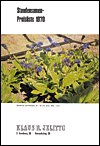 In 1970, our existing duplicated list of perennial seeds, which by that time had grown substantially, was replaced by a printed catalogue, initially fairly thin and with only few pictures, - colour printing was still very expensive. By 1976 however, we had considerably increased the number of pages with colour photographs.
In 1970, our existing duplicated list of perennial seeds, which by that time had grown substantially, was replaced by a printed catalogue, initially fairly thin and with only few pictures, - colour printing was still very expensive. By 1976 however, we had considerably increased the number of pages with colour photographs.
In 1979 we added seeds of Araucaria araucana (one seed = 4 gram) to our range. These seeds were collected at a height of 1800 m from the north side of the Lleima volcano in Chile (the hardiest possible source) and were sent to us by a member of the Botanic Gardens in Santiago de Chile. We sold tons of them. Abruptly in 1981, the contact broke off. We learnt from one of his friends that he had suddenly disappeared and nobody had seen him since. It was the era of Pinochet!
A colourful business
Our catalogue had been developing from year to year with a constantly increasing number of varieties and more and more colour photographs. Then, in 1992, for the first time we published an English version of our catalogue. Except, that it was not actually the first Jelitto catalogue in English. In 1991 while visiting a trade fair in the USA, I discovered a stall with our name and a pile of catalogues entitled "Jellito Staudensmen, Leaders in Perennial Seeds" Agents in USA. This was news to me! I had the exhibition organizers close the stall immediately. I still have one of these catalogues (full of mistakes) as a grotesque memento.
Some strange things happened to our company over the years, some of a criminal nature. During the early 1980s, I received a phone call from a friend of mine, owner of a well known, accredited seed company. He told me that the owner of a company in a neighbouring country had offered to give him tips on how to go about taking over Jelitto. My friend discovered that insider information was being leaked to this man. This opened my eyes. The person in question had been visiting several of our crop growers abroad and had been offering to buy the crops, or to give them contracts to work for him. He had even been trying to obtain samples of new varieties (partially bred by ourselves) to cultivate himself. Because we had good relationships with our growers, he was, as far as we know, only successful on one occasion. However, in 1984, we had our first large scale production of Echinacea purpurea "Magnus" in Königsluter. This was to be introduced in our 1985 catalogue. The grower received a lunchtime visit from this very same gentleman when nobody was in the nursery. The field in question was completely hidden behind a fenced off area and could only be reached through a gate which was behind a mound of compost. When retreating, the visitor had to pass by the owner's house, who happened to come out at that very moment. The visitor thanked him for the "guided" tour and was in a hurry to be gone; however, the grower was able to obtain his visiting card. Later he found tracks in the field and discovered that the first ripe spikes had been collected. Soon this company was selling the plants under a new name. This variety never became as popular as "Magnus". In 1988, of all the Echinacea in their trials, Magnus was given an award as the most "valuable variety" by the Versuchsanstalt für Gartenbau in Weihenstephan. "Magnus" was chosen as perennial of the year in 1998 in America and also in Sweden. In 2003, Echinacea purpurea "Magnus" was the only Echinacea to be given an Award of Garden Merit by the RHS. Without insider information these plants could not possibly have been found!
Overcrowding, again!
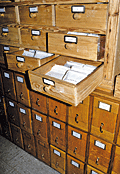 After we had given up the various other branches of our business and started concentrating on seeds, that side of the business boomed. All our energy was now put into this and of course, the result was that we needed more space. We required more for drying, cleaning, storing, for bigger refrigerators and more freezers, for the weighing and packing area, the laboratory and we needed more employees. So once again the company moved. This time from our own house in Hamburg to new premises about 1 km away, on the other side of the city boundary, in Wedel in Holstein. Our postal address remained Hamburg. The ever recurring space problem caught up with us yet again in 1985 and so we moved another 2 km away to a building which we had renovated in accordance with our specific requirements. In the meantime we were exporting seeds to more than 40 countries. Our catalogue, with even more pictures, had been greatly improved and enlarged. In 1986 we added books on perennials to our range of seeds.
After we had given up the various other branches of our business and started concentrating on seeds, that side of the business boomed. All our energy was now put into this and of course, the result was that we needed more space. We required more for drying, cleaning, storing, for bigger refrigerators and more freezers, for the weighing and packing area, the laboratory and we needed more employees. So once again the company moved. This time from our own house in Hamburg to new premises about 1 km away, on the other side of the city boundary, in Wedel in Holstein. Our postal address remained Hamburg. The ever recurring space problem caught up with us yet again in 1985 and so we moved another 2 km away to a building which we had renovated in accordance with our specific requirements. In the meantime we were exporting seeds to more than 40 countries. Our catalogue, with even more pictures, had been greatly improved and enlarged. In 1986 we added books on perennials to our range of seeds.
A survey which I undertook in 2002 showed that in 1961 only 464 species and varieties were on offer in the catalogues of the best known, renowned, international seed companies. Of these, 36 species were unavailable (due to bad crop etc.).In 2002 the Jelitto catalogue alone offered 2700 species, of which only 10 were unavailable. Our 2006 catalogue had a selection of 3200 seed varieties with 1000 pictures, almost all photographed by Georg Uebelhart.
Gold Nugget Seed®
and the potholes along the way
 In the early seventies I started experimenting with a treatment which aimed to accelerate germination in cold germinators and those slow, difficult to germinate, seeds. For reasons of discretion, I carried out these experiments in my hobby room at home without the help of my employees. Our two children tended the germination tests and a friend of my daughter who was a genius in chemistry, also helped. The breakthrough came in 1977 and the process was patented in Germany and Switzerland. The Dutch did their best to prevent the process from being patented in Holland. We had no idea who was behind this. All correspondence including our replies, had to be in Dutch. It was a pitiful and expensive tactic which lasted 16 years, the cost of translations etc. finally amounting to more than we actually paid for patenting in the other countries. In the 1978 catalogue I included a trial supplement for Gold Nugget seed with an extra order form. This was a complete success. Our achievement in shortening the duration of germination received a very positive response. In the beginning, success could be guaranteed with relatively few species. i.e. pulsatillas, 12 gentians, all lavenders, Trollius europaeus, 15 kinds of primulas and Viola odorata, too few to warrant separate pages in the catalogue. We also lacked the necessary workforce and space for this quite complicated process. Because of this, the first list using the protected name "Gold Nugget Seed®" was not published until 1993. Now it is a permanent feature in our catalogue and is very popular with customers.
In the early seventies I started experimenting with a treatment which aimed to accelerate germination in cold germinators and those slow, difficult to germinate, seeds. For reasons of discretion, I carried out these experiments in my hobby room at home without the help of my employees. Our two children tended the germination tests and a friend of my daughter who was a genius in chemistry, also helped. The breakthrough came in 1977 and the process was patented in Germany and Switzerland. The Dutch did their best to prevent the process from being patented in Holland. We had no idea who was behind this. All correspondence including our replies, had to be in Dutch. It was a pitiful and expensive tactic which lasted 16 years, the cost of translations etc. finally amounting to more than we actually paid for patenting in the other countries. In the 1978 catalogue I included a trial supplement for Gold Nugget seed with an extra order form. This was a complete success. Our achievement in shortening the duration of germination received a very positive response. In the beginning, success could be guaranteed with relatively few species. i.e. pulsatillas, 12 gentians, all lavenders, Trollius europaeus, 15 kinds of primulas and Viola odorata, too few to warrant separate pages in the catalogue. We also lacked the necessary workforce and space for this quite complicated process. Because of this, the first list using the protected name "Gold Nugget Seed®" was not published until 1993. Now it is a permanent feature in our catalogue and is very popular with customers.
The introduction of Gold Nugget Seed to the seed trade in 1978 caused so much interest that Jelitto received 5 international inquiries from would be buyers of the company. One very theatrical attempt lasted all of two years. Twice, we almost had a spy in our midst, disguised as a new employee. When these and other attempts failed, the strategy changed. The following is my supposition about an incident that took place a few weeks after the last attempt to buy our company had failed.
In the early hours of 21st November, 1989, a bank holiday, we had a break-in at our premises. What the burglars did not know, of course, was that because of the heavy workload, I too was going to be in the firm on that day. Someone must have been watching our house. As I arrived at the firm, I saw a car leaving in a cloud of dust. On entering the building, I noticed some damage to the doorway which had, however, withstood the break-in. Then I discovered that a window had been forced. Files lay strewn all over the floor. Every room had been ransacked. My desk, containing my personal belongings and my notes on the Gold Nugget procedure, had been broken open. At that moment I did not notice anything missing. I was however, surprised to see that my employees had forgotten to switch off the photocopier the day before, something that had never happened before. The police were unable to find any identifiable fingerprints. Neither the footprints below the forced window, nor the tyre tracks found in the yard led anywhere. Several weeks later, when I was unable to find my notes, I finally realised that the burglars had originally "only" wanted to photocopy the documents and were interrupted by me. In their hurry to escape they took the notebooks but forgot to switch off the photocopier.
The first voluntary removal
In October 1992 we decided to move the company once again, (our 8th removal in 35 years) although we were not actually short of space. Part of the motivation this time was the adjacent trial field bordering the premises. Until then I had always been able to use fields belonging to friendly companies, for which I am still very grateful. That arrangement had suited me well, providing me with an outside expert opinion on the development of my crop.
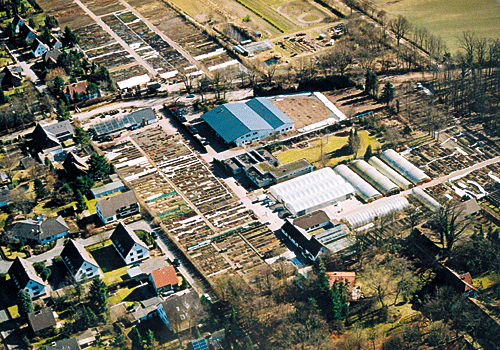 The reason for this move, however, was that the "Staudenkontor" co-operative in Schwarmstedt, consisting of 15 perennial growers from North Germany, was disbanding. Our family bought the land and buildings and converted these to suit our purposes.
The reason for this move, however, was that the "Staudenkontor" co-operative in Schwarmstedt, consisting of 15 perennial growers from North Germany, was disbanding. Our family bought the land and buildings and converted these to suit our purposes.
My biggest surprise came when all but one of my employees decided to move with us (140 km away). One employee found the decision very hard to make and finally agreed to move to Schwarmstedt for the first three months to help train a new colleague. This she did very conscientiously.
International activity on the increase
In 1983, a friend, Traudel Siebler, undertook a very successful first visit to our customers in the USA. Today she has a nursery for aquatic plants, together with J. Petrowsky, in Eschede. The following year I myself visited the USA. Two of our customers invited me to become a member of the Perennial Plant Association (PPA) which was in the initial stages of being registered. I became their first foreign member. They now have approximately 2500 members (including Canada). I became a regular visitor to their annual conferences. In this one week it is possible to meet up with almost all our American and Canadian customers - very practical. This helped our business in the USA to expand quickly and led us to open an office there in 1995, which is also responsible for Canada. This office is run by my friend Allen Bush (no relation to G.W.).
In the year 2000 we also opened an office in Great Britain which is run by Richard Oliver.
Discovery abroad
In 1987 whilst on a visit to the USA I happened to meet a young student from Switzerland who was working in the Maryland nursery of Kurt Bluemel, a friend of mine. I was impressed by his likeable nature and especially by the expertise he showed with the plants and seeds. I let him know that I would be interested in having him work for us when he finished his year in America. In 1988 he joined Jelitto.
 Today Georg Uebelhart is manager of the entire horticultural side of the business. Uli Schamp is personnel and commercial manager and is responsible for logistics and dispatch. He joined Jelitto in 1990. In 2003 Uli Schamp and Georg Uebelhart took over the majority of the company shares. We advised our customers of this that same year, in a folder composed by my son, in which we introduced them both in their new roles.
Today Georg Uebelhart is manager of the entire horticultural side of the business. Uli Schamp is personnel and commercial manager and is responsible for logistics and dispatch. He joined Jelitto in 1990. In 2003 Uli Schamp and Georg Uebelhart took over the majority of the company shares. We advised our customers of this that same year, in a folder composed by my son, in which we introduced them both in their new roles.
In 2004 Georg Uebelhart was given the international "Award for outstanding services of the Perennial Industry" by the PPA in the USA. He is also Chairman of the International Committee of the PPA.
One last word...
Finally I would like to thank you all, our growers and customers, without whose loyalty and cooperation this company would not be where it is today.
During the founding years, without even the aid of advertising, your numbers constantly grew, at home and abroad.
Over the course of the years we had gratifyingly few complaints but we have always been able to depend on your cooperation and understanding.
We were assured of your faith in us when less well known species, successfully introduced to the market by us, turned up in other catalogues under different variety names but you continued to buy from us, not being duped by these others.
We have always strived to repay this with botanical accuracy.
© Klaus R. Jelitto, Hamburg
 Have you forgotten your password?
Have you forgotten your password?

